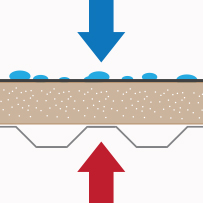
Roof moisture or leaks often go unnoticed until a problem presents itself that requires immediate action. However, leading up to that point there is often other hidden and not so hidden damage occurring.
Insulation Damage
Moisture entering a roof system can be absorbed by the insulation layer first, and then shows up as an interior leak. By this time, the moisture collection breaks down the roof insulation so it no longer offers the same R-value to the building. That is why it is important to use moisture-resistant insulation such as GenFlex’s Polyisocyanurate (Polyiso). Other insulating materials such as Expanded Polystyrene (EPS or Bead Board) can absorb water.
Roof Blistering
Moisture trapped inside a roof system can lead to roof blistering. As the water heats up under a hot roof it turns to vapor. The hotter it gets, the more it expands. This can cause roof blistering as the pressure of the vapor finds a weak point to expand. When the blister breaks there is yet another location for water to enter the roof.
Roof Deck / Structural Damage
When water seeps into a roof, it will make its way to the roof deck. If the roof deck is made of wood it can rot. If it is metal, typically galvanized or painted steel, it can start to corrode. While galvanized steel offers protection, it is not 100% corrosion proof, especially at fastening and weld points. If this condition is allowed to continue it can deteriorate to the point of deck failure, especially if stressed by another factor such as a heavy snow load.
If water from the roof makes it into walls, it can cause hidden damage such as rotting wood or mold growth. These scenarios are both expensive and hazardous to correct.
Moisture Can Come from the Inside
Most of us think of moisture as coming in from an exterior source such as rain water. However, it can also come from the inside. As warm, moist air rises, it can form condensation as the air contacts the colder underside of a roof deck. It can also find its way through seams and become trapped between the insulation layer and the roof membrane causing the same type of damage as described above.
If your business has excessive moisture output during normal operating conditions, such as from swimming pools or laundry facilities, it is essential to consult a professional to incorporate moisture alleviation techniques. Incorporating humidity gauges to read interior moisture accumulations and installing dehumidifiers are some actions that can be taken.
Roof Inspections and Maintenance
Implementing a regular roof maintenance plan with a GenFlex-authorized contractor can help identify areas of concern before they are a problem and prevent damage from trapped roof moisture. Having infrared scans of the roof performed can also aid in identifying areas of trapped moisture that need to be addressed. Locate a GenFlex-authorized contractor here.
